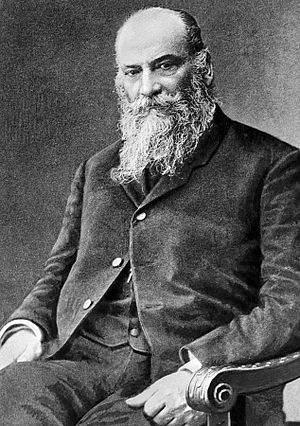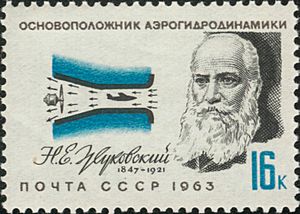Nikolay Zhukovsky (scientist) facts for kids
Quick facts for kids
Nikolay Yegorovich Zhukovsky
Никола́й Его́рович Жуко́вский |
|
|---|---|
 |
|
| Born | January 17, 1847 Orekhovo, Vladimir Oblast, Russian Empire
|
| Died | March 17, 1921 (aged 74) |
| Nationality | Russian |
| Alma mater | Moscow State University |
| Known for | Fluid Dynamics Founder of Aerodynamics |
| Awards | Order of Saint Anna Order of Saint Stanislaus Order of Saint Vladimir |
| Scientific career | |
| Fields | Mathematical Physics |
| Institutions | Imperial Moscow University Bauman Moscow State Technical University Moscow State University |
| Academic advisors | August Davidov |
| Notable students | S. Chaplygin L. I. Sedov V. V. Shuleikin |
| Influences | Ernst Mach Ludwig Mach Nikolai Brashman |
Nikolay Yegorovich Zhukovsky (Russian: Никола́й Его́рович Жуко́вский, IPA: [ʐʊˈkofskʲɪj]; January 17, 1847 – March 17, 1921) was a Russian scientist, mathematician, and engineer. He is known as a founding father of modern aerodynamics (the study of how air moves) and hydrodynamics (the study of how liquids move).
At a time when many scientists didn't believe humans could fly, Zhukovsky was the first to seriously study how air flows. Because of his important work, he is often called the Father of Russian Aviation. The Joukowsky transform and the Kutta–Joukowski theorem are named after him. These are important ideas in the study of how wings create lift.
Life and Discoveries
Nikolay Zhukovsky was born in the village of Orekhovo, in what was then the Vladimir Governorate of the Russian Empire. In 1868, he finished his studies at Moscow State University. He later became a professor at the Imperial Technical School in 1872.
In 1904, Zhukovsky started the world's first Aerodynamic Institute. It was located in Kachino, near Moscow. After 1918, he became the head of TsAGI, which is the Central AeroHydroDynamics Institute.
Zhukovsky was the first scientist to mathematically explain how lift is created. Lift is the upward force that keeps an airplane in the air. He showed that the lift force on an object moving through a fluid is related to its speed and the way the fluid flows around it.
He also used math to figure out the best shape for an airplane wing. This ideal shape has a rounded front edge, a certain thickness, and a sharp back edge. He also built the very first wind tunnel in Russia. A wind tunnel is a special tool used to test how air flows around objects.
Zhukovsky also worked on the "water hammer" equation. This equation is used by engineers to understand how pressure changes in pipes when water suddenly stops or starts flowing. He also helped develop the Joukowsky transform, which is a mathematical tool used in fluid dynamics. In 1920, he published his work on how much energy can be gotten from a turbine.
Nikolay Zhukovsky passed away in Moscow in 1921.
Lasting Recognition
Many things have been named in honor of Nikolay Zhukovsky. A city near Moscow is named after him. There is also a crater on the Moon called Zhukovskiy.
The Russian Air Force's engineering academy was named for him. It is now known as the Zhukovsky – Gagarin Air Force Academy. In May 2016, Moscow's fourth largest airport was also named in his honor.
In 1950, a movie about his life called Zhukovsky was made by Mosfilm. The Central Aero-Hydrodynamic Institute in Russia and the National Aerospace University – Kharkiv Aviation Institute in Ukraine are both named after him. There is also a museum dedicated to his memory.
Images for kids
See also
 In Spanish: Nikolái Zhukovski para niños
In Spanish: Nikolái Zhukovski para niños






